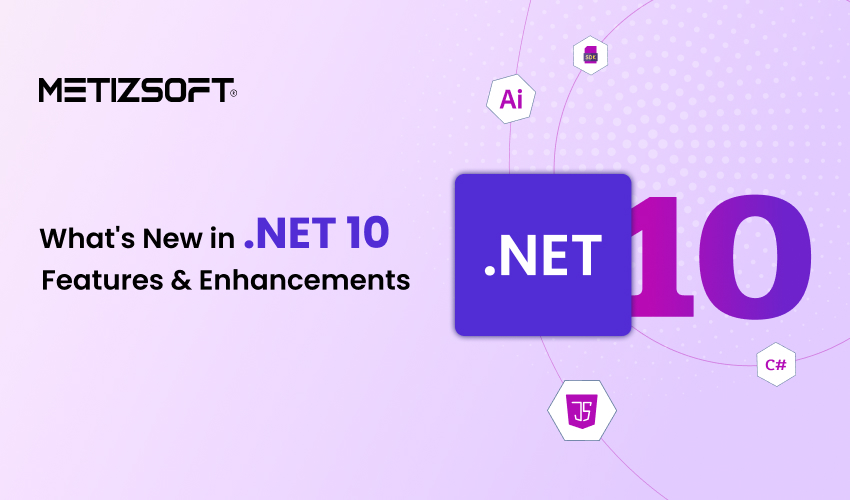
Dot Net development companies and enthusiasts assemble because your favorite cross-platform framework is here with the Long Term Support (LTS) release. This latest release, the LTS version, is here to stay for the next three years. It will include the latest updates that will lead to seamless optimization for you to build scalable modern applications for mobile, web, and desktop.
The Dot NET 10 release is packed with many significant improvements and is pledged to make application development smoother. So, let’s delve into this Microsoft-based framework’s latest release and understand what new feature it has for you. Plus the core updates and changes took place in the release that could potentially impact the coding of your next application.
Table of Contents
What’s New in .NET 10: Overview
.NET 10 brings a complete inventory of promising improvements in many key areas, such as:
AI and ML Enhancements: With the expanded ML.NET framework, NET 10 has made developers’ work easy regarding seamless integration with AI-powered applications. This upgrade will streamline predictive analytics, automation, and AI-driven decision-making.
Cloud Native and Microservice Support: The seamless integration of .NET 10 with Kubernetes and Docker has made microservice deployment. Now, you will enjoy an improvement in the performance of serverless computing in cloud environments like Azure, AWS, and Google Cloud.
Improved Security and Compliance: .NET 10 has improved security protocols with zero-trust architecture for enterprise security. Keeping in mind the increase in cyber threats, it has enhanced authentication mechanisms and stronger encryption techniques.
Enhanced Performance and Scalability: With this latest release of .NET 10, you will experience your application’s peak performance even with heavy traffic and workloads. The framework has optimized runtime efficiency and reduced memory consumption with better execution time.
Developer Productivity Improvements: Dot NET developers will find better debugging tools in Visual Studio, resulting in better error handling. Plus, they will get more improved support for containerized applications.
Key Features and Essential Enhancements of .NET 10
.NET 10 is a major Long-Term Support (LTS) release with many feature improvements. The best thing about these dot net enhancements is that it will stay for the next three years. It means more stability in performance, developer productivity, and security.
Here’s a list of .NET 10 key features and enhancements:
.NET 10 Libraries Enhancement
Better String and Data Handling: .NET has made some helpful updates to how you work with dates and texts. Now, handling dates (Calculating and Formatting) is easier with the ISOWeek class, which works smoothly with DateOnly. For text, you will find an improved tool called Unicode for organizing texts.
JSON Serialization Enhancements: Serialization in .NET 10 will help you turn data into a format that can be saved or sent, which is more flexible. Specifically, handling references in JSON is improved, giving you more control. Plus, for those of you who need really fast performance, the JsonSourceGenerationOptionsAttribute lets you fine-tune how your code handles serialization.
Improved Certificate Management: NET 10 has upgraded how certificates are managed, specifically with the FindByThumbprint method. Now, it can use more secure ways (hash algorithms) than just the old SHA-1. This is a big deal for digital security. This newer and stronger method will make certificate-based logins and verifications much safer and more dependable.
OrderedDictionary Enhancements: .NET 10 has been working even better with lists of data! Specifically, the OrderedDictionary tool now has improved indexing. This means when you add or look for data using TryAdd and TryGetValue, you’ll return that data’s location (index). This small change makes managing data much faster and more efficient.
ZipArchive Performance Optimization: The ZipArchive tool in .NET 10 now compresses and decompresses files with less memory and at a much quicker speed. This improvement is crucial for applications that handle big amounts of data, like those used for cloud storage or automated backups.
.NET Runtime Enhancements
Stack Allocation for Small Fixed-Sized Arrays: Now, when you use small, fixed-size arrays, .NET 10 stores them in a faster part of memory called the ‘stack.’ This reduces the extra work (overhead) of putting them in the regular memory area (heap). This is great for apps where speed is critical, like games, AI/ML calculations, and real-time data processing.
Optimized Just-In-Time (JIT) Compilation: The ‘JIT compiler,’ which turns your code into machine language, has been improved a lot. The .NET team has added new optimizations, like ‘method inlining’ and ‘loop unrolling,’ which make frequently used parts of your code run quicker. Plus, the enhanced ‘tiered compilation’ lets .NET automatically optimize code as your app runs.
Garbage Collection (GC) Enhancements: The ‘garbage collection’ (GC) process, which cleans up unused memory, is now more efficient. This means your real-time apps will run smoother with less delay. You will also experience a new way of memory management in the background to prevent it from getting messy (fragmented), which makes your apps run better overall.
Support for Advanced Vector Extensions (AVX) 10.2: You will find early support for AVX 10.2 in dot NET 10, which is a way to make your computer do the math and other calculations much faster. Right now, this feature is turned off by default. But, when new, compatible processors come out, it will make a huge difference, especially for things like number crunching, AI, and graphics.
ASP.NET Core 10 Enhancements
OpenAPI 3.1 Support: ASP.NET Core now fully supports OpenAPI 3.1, which means you can create detailed API documentation. The detailed API specification can be generated in its YAML format. This comes in handy when building microservices or designing APIs in an API-first approach or when the candidate APIs work with huge enterprise systems.
Blazor Performance and New Features: with an improved Blazor in Dot NET 10, your web pages will load faster. You can also use the newly added feature called RowClass to Blazor QuickGrid. These two features will let you easily change the look of rows in your tables using CSS, giving you more control over your website’s design.
Minimal APIs Enhancements: Minimal APIs are improving, allowing a programmer to create simplified HTTP services with less code. In other words, it will accelerate RESTful microservices development, while improving performance as well. If you are developing such services, these updates would really give a great productivity boost and let the applications run smoother.
Authentication and Authorization Enhancements: We have mentioned the security enhancement in Dot NET 10 in the overview section above. The framework comes with improved support for OAuth, OpenID Connect, and multi-factor authentication (MFA), which are all ways to make sure only the right people get access.
Changes in .NET Aspire 9.1
Enhanced Cloud Native Features: .NET Aspire 9.1 now works even better with cloud platforms. This means if you’re using containers or Kubernetes (which help run apps in the cloud), things will be more efficient in building modern cloud applications.
Improved Logging and Telemetry: The ‘structured logging’ and ‘distributed tracing’ features let you track down performance problems more easily. Its flexibility with components such as OpenTelemetry and Application Insights makes it easier to resolve issues that might arise during the operation of your application.
Updates in the .NET 10 SDK
Dependency Management Improvement: The optimized NeuGate package handling brings considerable improvement in restore times and the reliability of dependency resolution. This improvement makes managing libraries and third-party components more seamless.
Package Reference Pouring: .NET 10 automatically eliminates unnecessary package references, which reduces project dependencies and application size. This feature makes application development faster and makes sure the project structure remains clean.
Updates in C# 14 Language
Collection Expressions: The ‘collection expressions’ will help you write shorter and cleaner code when setting up these data structures. You don’t need to use the ‘new’ keyword as much, which makes things simpler and easier to read. This will be a big help when working with big lists of data in web apps or business software.
Improved Pattern Matching: The new ‘pattern-matching’ tool will help you write clearer switch expressions that also help prevent errors. Plus, you can now include your own custom ‘pattern-matching’ rules, which makes it simpler to build complex software designs (domain-driven design).
Primary Constructure of All Types: C# 14 makes sure ‘primary constructors’ work with all types of classes, which means you don’t have to write the same property setup code over and over again. This change makes ‘dependency injection’ easier to understand and use, and it helps keep your code clean by removing extra constructors. This is especially helpful when working with data models, DTOs (Data Transfer Objects), and simple services.
.NET MAUI for .NET 10
Performance Boost: Dot NET MAUI in .NET 10 uses less memory and render (draw). This means animations and transitions look appealing. It has also optimized the way your app’s user interface (UI) is drawn, so there’s less delay when you tap or interact with things.
Enhanced Device API: Now, dot net developers can deeply integrate with things like fingerprint or face ID (biometric authentication), advanced NFC (for contactless interactions), and better background tasks.
EF Core 10 Updates
JSON Column Mapping: EF Core 10 introduces seamless JSON column mapping, which you can use to store structured data (like JSON objects) in your database columns without needing to convert it into something else first. This simplifies working with flexible data and makes EF Core more powerful for situations where you need NoSQL-like flexibility within a SQL database.
Asynchronous Operations: The improved ExecuteUpdateAsync and ExecuteDeleteAsync methods allow you to update or delete many records at once without decelerating your application. Cloud-based applications are greatly facilitated when working with this feature since the bulk of workloads can impact data.
LINQ and SQL Translation Enhancements: LINQ queries, which help you get data, are now optimized to make fewer trips to the database and use indexes more effectively. We’ve also improved how LINQ expressions are turned into SQL, which means your data is retrieved faster, and your app handles multiple requests at the same time more efficiently.
Stored Procedure Mapping Enhancements: Now, it’s easier to connect your code to these procedures, especially when they return complex data. You can now directly link stored procedures to your code’s data models, so you don’t have to manually figure out the SQL results.
How Can You Migrate to .NET 10 From Previous Versions?
Migration to the present latest .NET fully depends on the strategic needs of your project. However, as one of the most reliable dot NET development Agency, we understand the importance of this upgrading and have really simplified .NET 10 migration in the following ways:
Step-1: Check System Requirements
- Any one of the following: Windows 10 or 11; macOS (latest version); or Linux
- Visual Studio 2022 (latest version) or JetBrains Rider
- Docker (if working with containerized applications)
After that, double-check that all third-party dependencies for .NET 10 are: Yes, you can check here how to view .NET versions installed on your system: dotnet –list-sdks
These are the requirements for the basic system that will be perfectly coordinated with the development environment for better and trouble-free results.
Step 2: Install .NET 10 SDK
Now that your system requirements have been checked download the .NET 10 SDK from the official website. Install it in your system and run!
You can use dotnet –version
When the command returns to a version number like 10.0.X, it means successful installation.
Step 3: Update Project Files and Dependencies
Your project files are most likely to be made on previous dot net versions (.Net 9 or more). In that case, you must update the project file to the latest .Net 10.
1. Modify the Target Framework in .csproj File
Locate your .csproj file and change the <TargetFramework> property
Before (for .NET 7/8):
<TargetFramework>net7.0</TargetFramework>
After (.NET 10)
<TargetFramework>net10.0</TargetFramework>
2. Upgrade NuGet Packages
dotnet nuget locals all –clear
dotnet restore
dotnet outdated
dotnet add package Microsoft.AspNetCore.App –version 10.0.0
Note: You can update dependencies manually in NuGet Package Manager within Visual Studio or hire dot net developers to complete the process for you!
Step 4: Refactor Code to Align with .NET 10 Standards
After dependencies update, it is crucial to check for deprecated APIs and rewrite code where necessary.
1. Identify and Replace Deprecated APIs
You can utilize the .NET Upgrade Assistant to analyze your project for outdated APIs:
dotnet upgrade-assistant analyze.
Tells you about old (deprecated) methods in your code and suggests better ways to do things.
Here are some common fixes you might need in .NET 10:
- Identity APIs update for authentication.
- Refactor Anti Framework Core Querry for compatibility.
- Use the new .NET core middleware configuration.
2. Apply C# 14 features for better code efficiency
.NET is coming with 10, C# 14, which gives new equipment to write code that is clean and easy to understand. It enables you to read more in your code and organize it better.
- Use Primary Constructors
C# 14 makes it easier to set up your classes. Now, you can use ‘primary constructors’ with all kinds of classes, which means you write less of the same repetitive code.
Before (.NET or older)
public class User
{
public string Name { get; }
public int Age { get; }
public User(string name, int age)
{
Name = name;
Age = age;
}
}
After (.NET 10 with C# 14):
public class User(string name, int age)
{
public string Name { get; } = name;
public int Age { get; } = age;
}
Before:
var numbers = new List { 1, 2, 3, 4, 5 };
After (.NET 10 with C# 14):
var numbers = [1, 2, 3, 4, 5];
Step 5: Test and Debug of the Upgraded Application
1. Unit Test
Use the following command to execute unit tests: dotnet test.
2. Performance Benchmarking Test
.NET 10 has improved performance, so running a benchmark will help you analyze your application speed.
Install BenchmarkDotNet and run tests:
dotnet add package BenchmarkDotNet
Example Benchmark Code:
using BenchmarkDotNet.Attributes;
using BenchmarkDotNet.Running;
public class PerformanceTest
{
private List numbers = Enumerable.Range(1, 1000000).ToList();
[Benchmark]
public void TestSorting()
{
numbers.Sort();
} }
BenchmarkRunner.Run();
Step 6: Rebuild, Deploy and Monitor
1. Rebuild and Publish
Run the .NET command to create a production-ready build:
dotnet publish -c Release -o ./publish. ( this code will generate optimized binaries for deployment.)
2. Deploy to the Production Environment
Deploy your application to a web server (your choice): Azure, AWS, or a self-hosted environment.
For Dockerized Applications:
If your application is containerized, update the Dockerfile to use .NET 10:
FROM mcr.microsoft.com/dotnet/aspnet:10.0 AS base
WORKDIR /app
COPY . .
ENTRYPOINT [“dotnet”, “YourApp.dll”]
Then rebuild and deploy:
docker build -t yourapp-dotnet10 .
docker run -d -p 5000:80 yourapp-dotnet10
End Note
With many new features, robust speed and optimization, and enhanced security, .NET comes with a staggering release to streamline software development for startups and enterprises. This latest version of dot net has advanced tools and many other improvements that improve its credibility to be the most stabilized cross-platform framework version in building modern, high-class web apps, enterprise solutions, or mobile applications.
But, understanding and implementing the latest version of any cross-platform framework is not as easy as it sounds. There are many stages involved that demand professional inclusion. So it’s highly recommended that you collaborate with a renowned dot net development agency like Metizsoft to explore .NET 10 and ensure seamless implementation in your next project.
AboutChetan Sheladiya
Related Posts
React vs. Angular- Which One Is The Ultimate Market Leader In 2021?
There are several front-end web development frameworks available in the market. Whenever someone plans to build an online app...
List of Outlines Why People Still use ASP.Net Web Forms in 2021?
Asp.Net is a cross-border platform used to deploy web apps on your Operating system. This web application framework started as...




